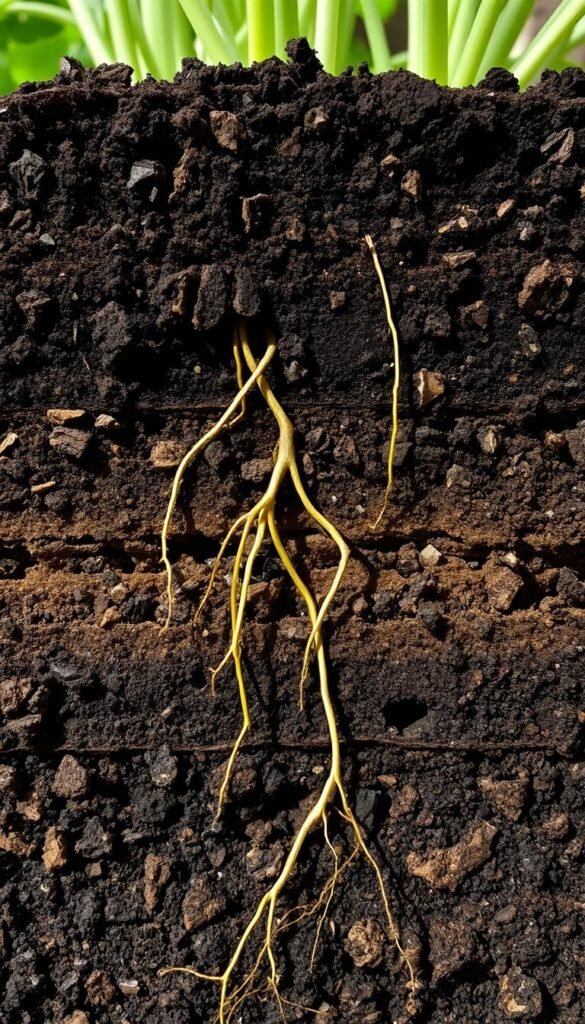Transforming your backyard into a thriving food source starts with choosing the right growing strategy. Two distinct styles dominate home food production: one rooted in centuries-old farming practices, and another leveraging modern soil-building techniques. Both methods can yield impressive harvests, but their approaches to preparing your plot and nurturing plants differ dramatically.
The first system uses organized planting patterns that make weeding and harvesting straightforward. This approach works well if you prefer clear boundaries between crops and enjoy hands-on maintenance. For those seeking a low-effort start, the no-dig gardening approach builds fertile soil by layering compost, leaves, and other organic materials—a process that mimics natural forest floors.
Your choice impacts everything from weekly chores to long-term soil health. Traditional setups often require more upfront digging and seasonal tilling, while layered beds improve nutrient retention over time. Studies show no-dig plots reduce weed growth by up to 75% compared to conventional methods, letting you spend less time battling unwanted plants.
Consider your available time, physical energy, and goals. Do you want immediate results or are you building a sustainable system for future seasons? Whether you prioritize structure or flexibility, understanding these methods helps create a productive space tailored to your lifestyle.
Introduction: Discover Your Garden Design Options
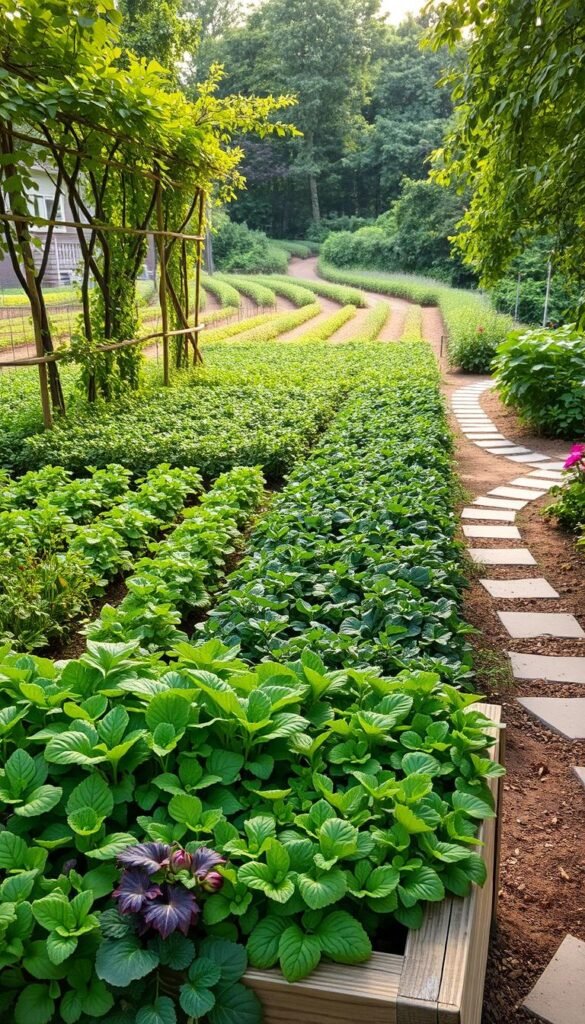
Your garden’s layout shapes not just its appearance but also its productivity and ease of care. Whether you’re drawn to time-honored techniques or innovative soil-building strategies, each approach offers distinct pathways to fresh, homegrown food.
What Are Traditional Rows?
This classic setup organizes crops in neat lines separated by walkways. You’ll appreciate the straightforward access for watering, pruning, and picking produce. The spacing between plants allows sunlight to reach leaves evenly while promoting airflow—key factors for preventing disease.
Exploring Layered Soil Building
Imagine creating fertile ground without turning a shovel. The lasagna technique stacks organic matter like newspaper, leaves, and coffee grounds to form rich planting beds. Over time, these layers break down into a fluffy, nutrient-packed foundation that retains moisture and deters weeds naturally.
Key differences emerge quickly:
- Traditional layouts demand annual digging and frequent weeding
- Layered systems improve earth quality season after season
- One method offers instant planting readiness; the other rewards patience
Your choice depends on whether you prioritize immediate results or long-term soil vitality. Both strategies can coexist—some gardeners dedicate areas to each based on crop types or personal preferences.
Understanding Traditional Row Vegetable Gardens
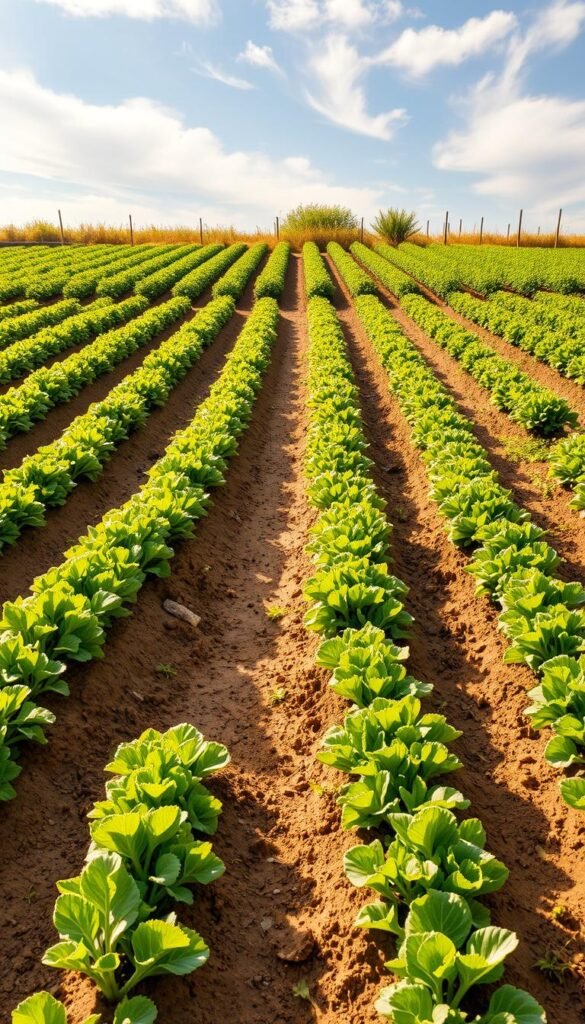
Growing food in straight lines offers a familiar rhythm many find satisfying. This time-tested approach creates order while letting you maximize space efficiently. Let’s break down what makes this system work.
Key Components and Layout
Your planting area needs three elements: crop rows, walking paths, and clear boundaries. Space rows 12-36 inches apart based on what you’re growing—leafy greens need less room than sprawling squash vines. This spacing lets sunlight reach all plants evenly while giving roots space to expand.
Paths between rows should be 18-24 inches wide. Compact the soil slightly there to prevent mud during watering. You’ll appreciate this design when harvesting tomatoes or trellising beans without stepping on delicate roots.
Soil Preparation and Planting Techniques
Start by removing existing grass completely—either through tilling or smothering with cardboard. Mix 3-4 inches of compost into the topsoil to boost nutrients. Rake the surface smooth before planting seeds or seedlings in straight lines.
Water along the base of each row using soaker hoses or drip irrigation. This method keeps leaves dry, reducing disease risks. Rotate crops yearly—plant nitrogen-loving corn where beans grew last season to maintain soil health naturally.
While this approach demands initial effort, it rewards you with predictable results. The organized layout simplifies pest control and makes fertilizing specific plants easier. Just remember: neat rows work best in larger spaces where you can move tools freely between crops.
Exploring the Lasagna Gardening Method
Imagine crafting nutrient-rich planting areas using nature’s recycling system. This innovative approach skips digging and instead stacks organic materials like a delicious layered dish. The magic happens as these components break down into dark, crumbly earth teeming with life.
Building Layers of Organic Material
Start by laying cardboard or newspaper directly on grass—this smothers weeds while inviting earthworms to work. Alternate green and brown materials like kitchen scraps and dried leaves. Each layer serves a purpose:
- Nitrogen-rich greens (grass clippings, coffee grounds) heat up decomposition
- Carbon-packed browns (shredded paper, wood chips) balance moisture
- Compost acts as the “cheese” binding everything together
“Properly built lasagna beds can shrink by 50% as materials decompose, creating concentrated nutrients.”
How Lasagna Beds Enhance Soil Quality
These layered beds become self-fertilizing systems. Microorganisms transform waste into plant-ready food while improving drainage. You’ll notice fewer weeds and less watering needs compared to tilled plots.
The technique boosts biodiversity underground. A single shovelful of finished soil from these beds contains more microbes than there are people on Earth. This living network helps plants access nutrients and resist diseases naturally.
Comparing In-Ground Vegetable Garden Design: Traditional Rows vs. Lasagna Method
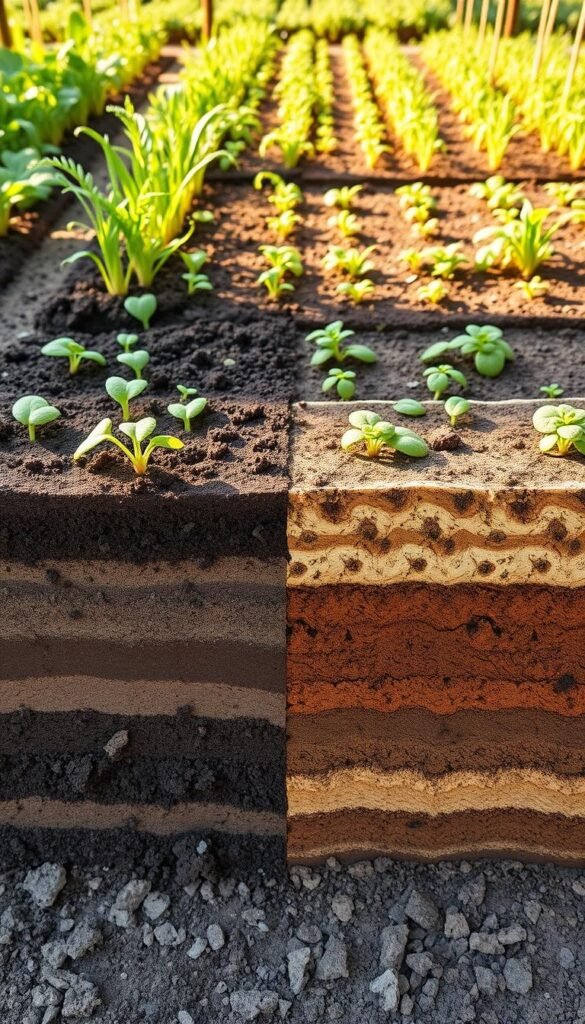
Your soil’s hidden potential determines whether your plants thrive or just survive. Let’s break down how these growing strategies feed your crops and shape your schedule.
Feeding Your Plants Naturally
The layered method acts like a slow-release vitamin for your plot. As banana peels and fallen leaves decompose, they pump nitrogen and potassium into the earth. You’re essentially growing rich topsoil that gets better each season.
Traditional setups need regular boosts. You’ll mix compost into tired earth every spring, fighting to maintain nutrient levels. While effective, this approach resembles constantly refilling a leaky bucket compared to lasagna’s self-renewing system.
“Lasagna beds transform dirt into living soil faster than any tilling process.”
Balancing Effort and Results
Weekend warriors might prefer traditional plots—dig once, plant immediately. But grab your shovel every year. Layered beds demand patience during setup, yet reward you with:
- 75% less weeding after the first season
- Free materials from yard waste
- Automatic water retention
Your choice boils down to priorities. Need instant gratification? Stick with rows. Building lasting soil quality? Layer up. Both paths lead to juicy tomatoes, but one keeps giving back to the earth.
Pros and Cons of Traditional Row Design
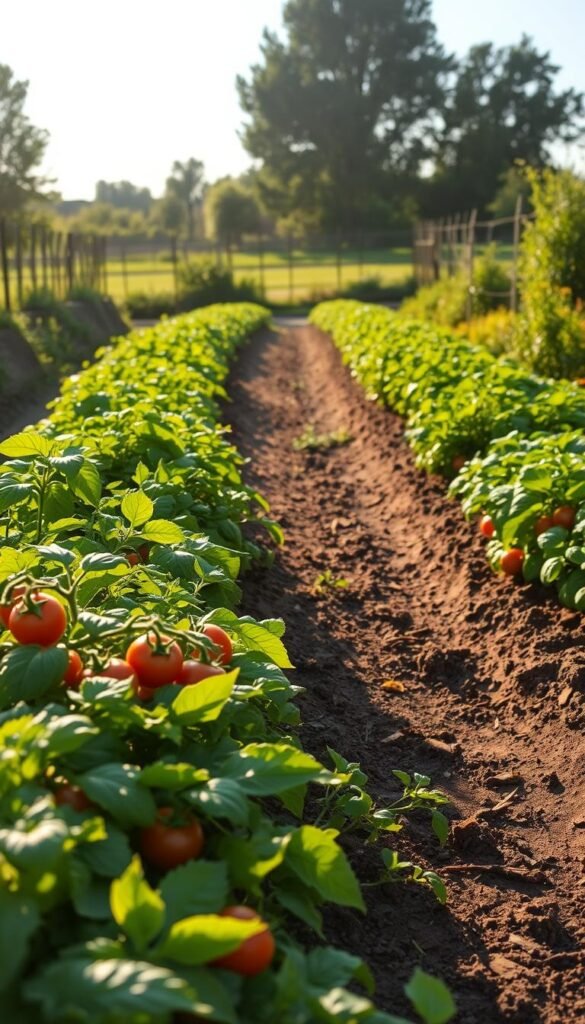
Every gardening method involves trade-offs between convenience and long-term benefits. Row-based setups shine for their simplicity but reveal limitations over seasons. Let’s explore what makes this approach work—and where it might test your patience.
Advantages for Quick and Organized Planting
You’ll love how fast you can start growing. Once you’ve cleared grass and tilled the earth, seeds go straight into prepared rows. No waiting for compost layers to break down—ideal for gardeners craving instant results.
The orderly layout simplifies care routines. Space plants evenly for sunlight access, and run drip lines along each row. Mechanical tillers fit perfectly between crops in larger plots, saving hours of manual labor. Beginners especially appreciate this clarity when planning layouts for multiple vegetable types.
Limitations in Soil Improvement and Flexibility
Here’s the catch: rows work with what you’ve got. Existing soil quality dictates plant health unless you add store-bought fertilizers. Expect to replenish nutrients annually through amendments, which adds costs over time.
Weeds thrive in disturbed earth between crops. You’ll battle invaders weekly unless you mulch heavily. Unlike self-enriching layered beds, traditional systems demand constant upkeep to maintain productivity. The rigid structure also limits creative planting patterns that maximize small spaces.
Pros and Cons of Lasagna Gardening
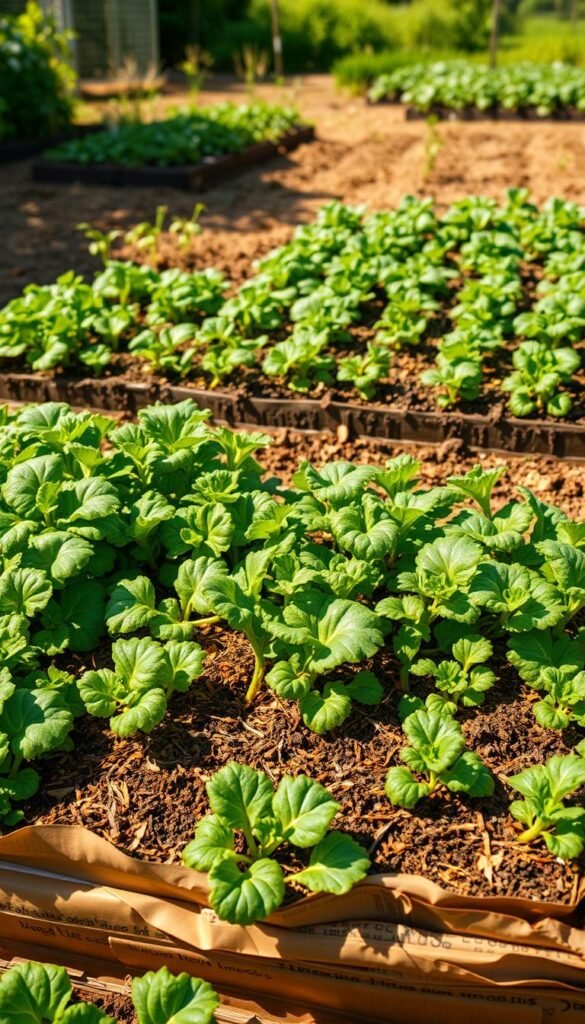
Creating a thriving garden doesn’t require backbreaking work—lasagna gardening turns household waste into fertile ground. This technique offers unique benefits but asks for thoughtful planning. Let’s explore what makes it shine and where challenges might pop up.
Rapid Nutrient Build-Up and Weed Suppression
Your layered bed becomes a nutrient factory. As kitchen scraps and leaves decompose, they release a steady stream of plant food. The cardboard base smothers existing weeds while blocking new ones—no herbicides needed.
“A well-built lasagna bed can suppress 90% of weeds in its first year through natural smothering.”
| Advantages | Challenges |
|---|---|
| Eliminates 75%+ weeding work | 3-6 month setup for planting |
| Uses free yard/food waste | Needs 12+ inches of materials |
| Retains 40% more moisture | Oxygen issues in clay soils |
Maintenance of Organic Layers Over Time
Your lasagna garden shrinks as it cooks—expect to add fresh layers each fall. While this maintains fertility, it demands ongoing material collection. Watch for matting in rainy climates; fluff with straw to keep air flowing.
Heavy clay soils need extra care. Mix in coarse materials like wood chips to prevent dense clumps. Test drainage by digging a small hole—water should disappear in 10 minutes. If not, add more brown materials next season.
Considering Environmental and Climate Factors
Your local weather patterns and seasonal shifts shape how your growing space performs. What thrives in Arizona might struggle in Minnesota—choosing the right strategy ensures your efforts bear fruit.
Adapting Methods for Different U.S. Climates
Layered beds shine in mild coastal regions where spring rains and summer warmth speed decomposition. In arid areas, consider Hugelkultur—burying logs under soil traps moisture like a sponge. These setups reduce watering needs by 30-50% compared to row-based plots.
Traditional systems work nationwide but need tweaks. Add peat moss to sandy desert soil, or mix gypsum into dense clay. Rotate crops more frequently in humid zones to prevent disease.
“Lasagna beds built in fall develop richer nutrients by planting season—microbes work through winter in milder climates.”
Match your schedule to nature’s clock. Start layered beds 6 months before planting in cooler regions. Use fast-breaking materials like grass clippings if your growing season is short. Coastal gardeners can layer year-round, while northerners should prep during thaw periods.
Materials and Process: Building Your Ideal Garden Bed
Your journey to fresh harvests begins with understanding what fuels plant growth. Whether you prefer materials you can gather from home or structured processes, both approaches offer routes to success. The key lies in matching your effort to the results you crave.
Smart Material Selection
Start by collecting organic material like leaves, grass clippings, and kitchen scraps. These free resources become black gold when layered properly. For quick starts, mix finished compost into existing soil—it’s like giving plants a multivitamin boost.
Building for the Long Haul
Raise your garden bed’s potential through thoughtful stacking. Alternate green and brown layers to spark decomposition. Over time, these materials break down into moisture-retentive earth that feeds roots naturally.
Your choice shapes maintenance needs and harvest quality. Immediate planting? Stick with simple soil amendments. Investing in layered organic material pays off with richer yields down the line. Either way, your plants will taste the difference.

